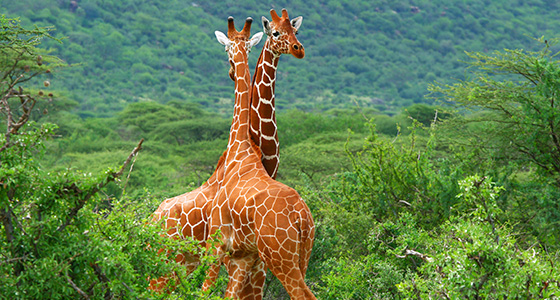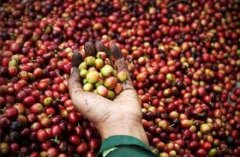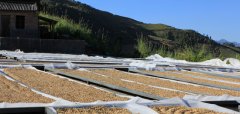What is Kenya AA Kenya Coffee Overview Kenya Coffee Auction with Direct Trade Grown Ways
History of coffee in Kenya
Although it is adjacent to Ethiopia, the birthplace of coffee, coffee cultivation does not have a long history. It is generally believed that coffee was brought to Kenya in the late 19th century by the priests of the Holy Spirit Church (FathersofHolySpiritcongregation). It is more common to say that it came from the island of Reunion (Bourbon, where coffee was found in Bourbon) in 1893, or from Ethiopia.
When coffee first arrived, Kenya was under British rule, and coffee cultivation was promoted to earn foreign exchange. In 1963, when Kenya became independent, the status of coffee did not decline, but was consolidated and was an important component of Kenya's trade income.
Coffee growing area in Kenya
The coffee producing areas in Kenya are mainly concentrated in the plateau areas represented by Mount Mt.Kenya. Tropical climate, acid red volcanic soil provides a natural and suitable growth environment for coffee. The main producing areas are Nyeri and Ruiru in the middle of the country.
Kenyan Coffee: Overview
Kenyan coffee varieties
Bourbon Bourbon was first brought to Kenya for planting. In the 1950s, the then agricultural research institution ScottLaboratory selected two excellent hybrids, SL-28 and SL-34, through unremitting efforts, subverting the long-standing prejudice that artificial breeding is not superior to natural varieties. SL-28 and SL-34 help Kenyan coffee to form its own unique flavor characteristics and establish a perfect reputation in the coffee industry.
Like the choice of other coffee producing countries, although SL-28 and SL-34 have stood the test of time and cultivated generation after generation of faithful pumps for Kenyan coffee, for the sake of coffee yield and disease resistance, the Kenyan government and the Coffee Research Institute (CoffeeResearchFoundation) have begun to promote a new variety, Ruiri11, and the promoters assure coffee lovers that the new variety still has the classic flavor of Kenyan coffee. However, the continuous efforts have not won the recognition of coffee gluttons, who agree that the new varieties lack taste and that the future of Ruiru11 remains to be seen.
In addition to the prestigious traditional Arabica coffee, robusta coffee is also produced in the western lowlands of Kenya.
Coffee cultivation in Kenya
Mainly by large farms (Estate) and cooperatives (Cooperatives) two types. The former generally has a large planting area and has independent coffee processing facilities. Most coffee production is done by a large number of small farmers, who form coffee cooperatives. The Coffee Cooperative Society employs special managers to supervise the coffee processing of its members, even to the point of managing each coffee tree.
Compared with shading planting in many high-quality producing areas, Kenyan coffee is obviously more spicy and unrestrained, and shade trees are not common. In addition, Kenyan coffee rarely participates in certification, variety and environmental factors make the use of pesticides necessary, and organic certification, which is popular in other countries, becomes rare in Kenya.
Kenyan coffee harvest season
There are two harvest seasons in Kenya, the main harvest season is from October to December and the secondary harvest season is from May to July.
Kenyan coffee processing
Large farms usually have independent treatment facilities. A large number of small farmers usually pick ripe coffee fruits by hand. Coffee picking is a labor-intensive job that requires the whole family to deploy and even hire workers during the harvest season. The fresh fruit of the picked coffee needs to be delivered in time to the cooperative-owned coffee processing plant for pulping, which may be carried by ox carts, pick-up trucks or trucks. After peeling, Parchmentcoffee is briefly kept in the cooperative's processing plant and sent to a privately owned factory for shelling treatment.
Kenyan Coffee: Overview
Coffee auction and Direct Trade in Kenya
Almost all Kenyan coffee is sold through the coffee exchange in Nairobi, the capital. Coffee auctions are held at coffee exchanges every Tuesday during the harvest season. Traders with trading qualifications will get raw bean samples in advance, and after the cup test, they will choose the raw beans they like. In the following auction, the highest bidder will get. Kenya's coffee auction system is regarded as the model of the popular COE tournament, and it is regarded as the most transparent and efficient way of trade, which can effectively encourage growers to pursue quality and achieve high quality and high price results.
Although the coffee auction system has effectively improved the price of high-quality coffee, it is not without drawbacks. First, the existence of many trade middlemen has eroded the interests of coffee farmers, and the high prices obtained from the auction can not be fully fed back to the hard-working coffee farmers. Second, it is difficult to accurately trace the production information of auctioned coffee. For the booming boutique coffee market, traceability is an important criterion for the evaluation of raw coffee beans. Based on the above factors, the Kenyan government has begun to relax restrictions on direct trade in coffee. State-certified agents can sell coffee beans directly to customers such as foreign boutique coffee roasters. Direct trade can give farmers more rewards for producing high-quality coffee.
Kenyan Coffee: Overview
Kenyan coffee grade
Kenya is a well-known producer based on the size of coffee beans. Usually divided into nine grades, according to the bean type, there are PB, that is, round beans, accounting for about 10% of the total output, in addition to E (elephant beans), AA, AB, C, T, TT, MH, ML according to size.
Coffee related institutions in Kenya
KCPTA: Kenya Federation of Coffee producers and traders, KenyaCoffeeProducersandTradersAssociation
CRF: Kenya Coffee Research Institute, CoffeeResearchFoundation
KCB: Kenya Coffee Exchange, KenyaCoffeeBoard
KCTA: Kenyan Federation of Coffee traders, KenyaCoffeeTradersAssociation
[KenyaNyeriGatugiAA]
Country: Kenya
Grade: AA
Production area: Nyeri Central Dashan area
Altitude: 1600-2300 m
Soil quality: volcanic clay
Treatment: washing
Variety: SL28,SL34
Processing plant: Gatugi processing plant
Producer: small coffee farmers
Flavor: floral aroma, blackcurrant, cranberry

Important Notice :
前街咖啡 FrontStreet Coffee has moved to new addredd:
FrontStreet Coffee Address: 315,Donghua East Road,GuangZhou
Tel:020 38364473
- Prev

Introduction of Ethiopian Fine Coffee Flavor characteristics of Ethiopian Coffee
Ethiopia is an agricultural country with a history and tradition of coffee origin. The place where the name coffee comes from is Kafa in the southwest, while the Sidamo place in the south is the main producing area, and Yegashafi is one of the southern producing areas of Sidamo. The Eastern Highland Hara is as famous as the coffee name Hara. Ethiopia is an important coffee producer.
- Next

Introduction to the Flavor of Papua New Guinea Coffee
In recent years, Papua New Guinea Coffee began to wash Arabica beans with its own unique high-quality water, representing Asia to enter the ranks of the world specialty coffee. The coffee style of Papua New Guinea has the characteristics of full particles, moderate acidity and mellow taste. Papua New Guinea is an island country in Oceania. Papua means curly hair in Malay.
Related
- Does Rose Summer choose Blue, Green or Red? Detailed explanation of Rose Summer Coffee plots and Classification in Panamanian Jade Manor
- What is the difference between the origin, producing area, processing plant, cooperative and manor of coffee beans?
- How fine does the espresso powder fit? how to grind the espresso?
- Sca coffee roasting degree color card coffee roasting degree 8 roasting color values what do you mean?
- The practice of lattes: how to make lattes at home
- Introduction to Indonesian Fine Coffee beans-- Java Coffee producing area of Indonesian Arabica Coffee
- How much will the flavor of light and medium roasted rose summer be expressed? What baking level is rose summer suitable for?
- Introduction to the characteristics of washing, sun-drying or wet-planing coffee commonly used in Mantenin, Indonesia
- Price characteristics of Arabica Coffee Bean Starbucks introduction to Manning Coffee Bean Taste producing area Variety Manor
- What is the authentic Yega flavor? What are the flavor characteristics of the really excellent Yejasuffi coffee beans?

